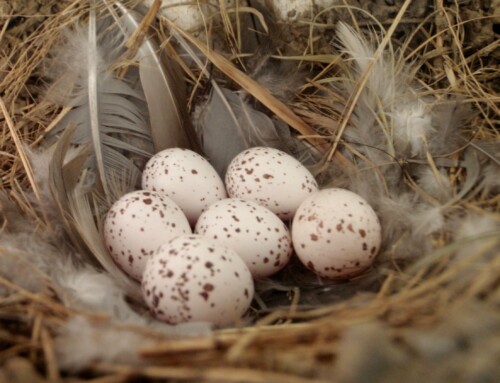Differing responses of closely related migratory and resident species
LINKED PAPER
Diversification of a ‘great speciator’ in the Wallacea region: differing responses of closely related resident and migratory kingfisher species (Aves: Alcedinidae: Todiramphus). O’Connell, D.P., Kelly, D.J., Lawless, N., Karya, A., Analuddin, K. & Marples, N.M. 2018. IBIS. DOI: 10.1111/ibi.12688. VIEW
Studying diversification in the Todiramphus kingfishers of Sulawesi often brought to mind the adage, ‘what is rare is beautiful’. Though I certainly also learned that rare beauties can be incredibly frustrating! While I could be guaranteed to catch my other main study taxa, Zosterops white-eyes, by the dozen in the right habitat, Collared Kingfishers (Todiramphus chloris) and Sacred Kingfishers (Todiramphus sanctus) were much more elusive. This made them maddening study species, but ensured that every time I got to grips with one was a special moment. Each bird caught was measured and had a few flank feathers taken before release. Even the most disappointing site could be made worthwhile by catching a kingfisher. In particular, I’ll never forget a particularly fetid swamp in the backwoods of Sulawesi, as I’m pretty sure all the mosquitos in the world lived there. It yielded our worst ever bird catches, but two crucial Collared Kingfishers! These moments of elation have stuck with me, and have ensured that the Todiramphus kingfishers are the study species I’m most fond of.
In our recent paper in IBIS we investigated the diversification of these elusive kingfishers in South-east Sulawesi, Indonesia, in the heart of the Wallacea region. Todiramphus kingfishers have long been central to the study of speciation, with Diamond et al. (1976) naming Collared Kingfishers one of the ‘great speciator’ lineages of the Indo-Pacific, a group defined by the remarkable tempo of their diversification throughout the region. Our work was inspired by that of Andersen et al. (2015) who assessed the phylogenetic patterns of this diversification across the Indo-Pacific, finding Todiramphus to be one of the most rapidly evolving groups of birds. Andersen et al. (2015) also found that the Collared Kingfisher was actually made up of at least 10 distinct species, but that the migratory Sacred Kingfisher was remarkably undifferentiated across its broad range. Our work aimed to gain a deeper understanding of how the early stages diversification occur in isolated populations of Todiramphus kingfishers, by combining denser genetic sampling with morphological data. In our study system we sampled Collared and Sacred Kingfishers on mainland Sulawesi and its large continental islands, and on the oceanic archipelago of the Wakatobi Islands.


We found that populations of Collared Kingfisher on the Wakatobi Islands had diverged from those on mainland Sulawesi, differing in genetics and having a significantly larger body size. In contrast there was no divergence between Sacred Kingfisher populations in either morphology or genetics. We propose that a difference in habitat occupied by Collared Kingfisher populations between the mainland and continental islands, versus oceanic islands, has caused this divergence. On the mainland Collared Kingfishers are predominately found inland, while Sacred Kingfishers are found along the coastal fringe. However, the Wakatobi Islands contain less habitat diversity and are mostly dominated by coastal scrub, so Wakatobi Collared Kingfishers are found in coastal habitats. The larger body size of Wakatobi Collared Kingfisher populations may be a result of increased competition with predominantly coastal Sacred Kingfisher populations. This increased body size in the Wakatobi Collared Kingfishers may allow partitioning of feeding niche with the Sacred Kingfisher, as they no longer partition habitat on these small islands. The uniform nature of Sacred Kingfisher populations in this region likely reflects their consistent habitat choice (coastal mangrove) and their migratory nature. The demands of their breeding range are likely to have an even stronger selective influence than their Sulawesi wintering range, limiting their scope for divergence.
This research illustrates a possible mode of divergence at the early stages of speciation in an isolated Todiramphus population. Populations of ‘great speciator’ lineages such as the Collared Kingfisher may provide an ideal opportunity to gain insight into the early stages of speciation. Their rapid speed of evolutionary change, ability to colonise islands and the frequency with which they are found in competition with close relatives makes ‘great speciators’ ideal groups in which to study speciation. Additionally we believe that the Wakatobi Collared Kingfisher population may represent an unrecognised subspecies and recommend assessment of type specimens to ensure this unique population is recognised and protected.
References
Andersen, M.J., Shult, H.T., Cibois, A., Thibault, J.-C., Filardi, C.E. & Moyle, R.G. 2015. Rapid diversification and secondary sympatry in Australo-Pacific kingfishers (Aves: Alcedinidae: Todiramphus). Royal Society Open Science 2: 140375. VIEW
Diamond, J.M., Gilpin, M.E. & Mayr, E. 1976. Species-distance relation for birds of the Solomon Archipelago, and the paradox of the great speciators. Proceedings of the National Academy of Sciences 73 (6): 2160-2164. VIEW
Image credits
Featured image: Sacred Kingfisher, Todiramphus sanctus © Darren O’Connell
Blog posts express the views of the individual author(s) and not those of the BOU.
If you want to write about your research in #theBOUblog, then please see here.





